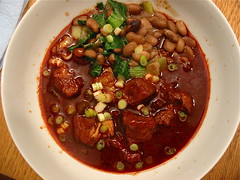“Four–chops. I’ve just written the word ‘chops.’ Not really sure where I was going with that one. Any idea?” –The Pirate Captain
I suspect he was reading Jennifer McLagan’s new cookbook, Fat, and slavering over the cover photo of lamb chops.
Wow, talk about a niche product. Would you buy a whole cookbook about animal fat? I would, but I suspect there are few like me. Prove me wrong.
The book is divided into four sections: butter, lard, poultry fat, and beef/lamb fat. You’ll find recipes for duck rillettes, bone marrow crostini, salt pork and lentils. The text is liberally marbled with aphorisms and anecdotes.
> Goose grease could also be found in the medicine cabinet, as it was the main ingredient for making a hot poultice to treat chest colds and bronchitis.
Aaagh! Mom, get away!
Anyway, if you’re already convinced that animal fat is good for you, you’re going to love this book, and if not, you won’t make it past the cover. I do wish the butter section had been chucked in favor of a section on solid vegetable fats like palm and coconut oil, which are even less appreciated in the American kitchen than duck fat.
I’ve cooked one recipe from _Fat_, for Miso- and Orange-Roasted Pork Belly, and I’ll give you my version of the recipe and how I reworked it.
MISO-ORANGE PORK BELLY
Adapted from _Fat_, Jennifer McLagan
*The original recipe makes a larger quality and calls for making a pan sauce, but (a) I made this specifically for the leftovers, and (b) I don’t own a roasting pan.*
1 pound boneless, skinless pork belly
salt and pepper
3 cups water
2 tablespoons miso (recipe called for red; I only had white; end result was tasty)
1 tablespoon honey
1 tablespoon brown sugar
2 teaspoons grated ginger
1 clove garlic, minced
zest of 1 small orange
1. Preheat oven to 425°F. Using a sharp knife, score the fat of the pork belly in a crosshatch pattern. Season with salt and pepper. Place the pork on a rack set in a roasting pan (or sheet pan). Add 2 cups water to the pan and roast the pork for 30 minutes. Meanwhile, stir together miso, honey, brown sugar, ginger, garlic, and orange zest.
2. Reduce heat to 325°F. Brush the top of the pork with half the miso mixture. Add remaining 1 cup water to the roasting pan and roast 30 minutes. Brush with remaining miso mixture, add more water if the pan is try, and roast 30 minutes. Transfer the pork to a plate, tent with foil, and rest ten minutes. Slice and serve, or see below.
PORK AND BEANS
a few ounces leftover miso-orange pork belly, cut into lardons
1 pound fresh cranberry beans, shelled
1/2 cup chicken broth
1/2 cup diced red onion
salt and pepper
minced fresh parsley
1. Bring a pot of salted water to a boil. Add the beans and boil until tender, about 20 minutes. Drain.
2. Meanwhile, cook the pork in a skillet over low heat until browned and beginning to crisp, about 20 minutes. Add a little olive oil if the pork fails to render enough fat.
3. Remove the pork from the pan and add the onion. Raise heat to medium and cook until soft and browned, about 10 minutes. Add the pork, beans, and chicken broth and simmer briefly. Season with salt and pepper, stir in parsley to taste, and serve, garnished with additional parsley.
*This book was given to me as a free promotional copy.*

